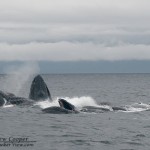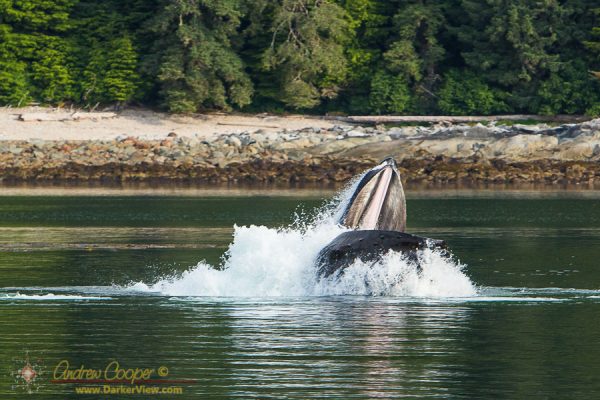
Tag: Humpback
Bubble Net Feeding
Postcard from Alaska – Whale Tail
Bubble Net Feeding
It is one of those spectacles of nature that you will never forget. I have seen a total solar eclipse, a meteor storm, calving glaciers, flash floods, come eye-to-eye with a grizzly bear, and I have witnessed bubble net feeding.

It is the last part of a carefully coordinated feeding maneuver that we see at the surface. One or two whales trap a school of herring by means of a circular wall of bubbles blown underwater. The whales swim in a tight circle, forcing the prey into a tight ball. Once the setup is complete the entire pod of whales charge vertically through the net, sweeping through the bait ball with open mouths. They all come up together at the end, with ventral pleats distended, full of water and herring to be filtered through the baleen.
The process is often repeated several times as the whales eat their fill. For the spectator the challenge it to guess where they will come up. If you want good photos it is necessary to be aimed and ready when the whales erupt from the water. To do this you must watch the birds. There is often a flock of gulls awaiting the whales, hoping to scoop up dazed herring forced to the surface in the net. From their vantage point well above the water the gulls see the net before you do, the entire wheeling flock suddenly heads in one direction, that is where.
Nordic Quest 2013
Sorting through thousands of photos, dozens of video clips, and assembling time-lapse from yet more thousands of frames, all to create a mere five minutes of video. It is quite the chore, but also a lot of fun. In a way I relive the voyage, each photo a cue to recall all of the little experiences that make a great trip.
Having another couple photographers along provided a great source of material, it is not all of my photos. Randy and Nancy sent me some of their best, which have been woven in to create a better video. We got lucky on the weather, while it was cloudy and rainy for much of the time, we had a glorious day for visiting the ice at the top of Glacier Bay. We were lucky with wildlife as well… Orca, grizzly, humpback whales bubble netting, mountain goats, eagles, even a set of fresh wolf prints on a beach, all of the big game.
It was fun…
Nordic Quest 2013 from Andrew Cooper on Vimeo.
Postcard from Alaska – Bubble Net
Counting Whales
At some points there were half a dozen different groups of whales in sight at the same time. The spotters called whale activity in a confusing chorus of activity and locations. The annual Hawaiian Islands Humpback Whale National Marine Sanctuary Ocean Count picked a pretty good day. Given the recent winter storm I had half expected to be rained out, some of the east Hawai’i sites were, but we had perfect conditions.

Not that we always needed to look that far, often enough the whales were at the base of the bluff, just a few hundred yards below us. In one half hour data interval we counted 24 breaches. Just a few whales around.
No argument, it was a good morning to be counting whales. From the looks of the preliminary results, our site counted far more whales than any other site across the islands. No surprise, this stretch of coast is always thick with whales. The only sites that challenge MM7 are the sites just north and south, Lapakahi and Pu’ukohola Heiau, from the data those folks had a good day as well.
Crossing Paths with a Humpback
Any sort of water activities, fishing or scuba diving, off the Kohala coast in winter involves a chance of seeing a whale. Indeed, Kohala is not just the part of the island we call home, it is the Hawaiian word for whale. In winter the whales are here in large numbers… Boat or drive north of Kawaihae and the odds approach certainty that you will see not just a few, but a lot of Humpback Whales as they cruise the waters along this sheltered coastline. Rental cars are parked along the coastal highway wherever a pod can be seen. Just getting to a dive site can involve navigating around a pod or two as blows and fins are seen in all directions. Dive beneath the water and you can listen to the songs of the whales echoing eerily through the blue.


In past journeys to Alaska I have had many opportunities to watch these majestic animals. We regularly stop and watch when we get the chance, drifting while whales feed around us. Hopefully this results in good photos to enjoy and post on the blog. At the end of the trip I fly back to Hawai’i to resume my usual life. But when winter comes the Humpbacks will follow, returning to the warm tropical waters around the islands to mate and give birth to the next generation. I look forward to seeing them off the Kohala Coast and listening to their songs while diving in those warm waters.
What are the odds of encountering the same whale at both ends of this journey? I wonder.
Counting Whales
It is that time again! Time for Ocean Count 2012… A morning spent spotting and counting whales for the Hawaiian Islands Humpback Whale National Marine Sanctuary.
The sanctuary staff recruits teams to crew sites all around the islands. All together, 61 teams with over 950 volunteers observed whales from Kauai to Hawai’i today. Twenty one teams set up to cover the Big Island from South Point to Opolu Point. The procedure is to observe whales from 8am to noon, recording the behavior in half hour time slots. Every blow, dive, breach or other activity is recorded. The technique is to work in teams of two, one person spotting, binoculars in hand, the other writing as the whale activity is called out.

Deb Cooper counting whales north of Kawaihae
A bluff overlooking Pelekane Bay has been our site for the last three years. Mile Marker 7 is a perfect place to observe whales. A bluff well above the water. A rocky knoll covered with lawn chairs, coolers, and well over twenty observers peering through binoculars.
This year was much like the last several years. We counted dozens upon dozens of whales from the MM7 site, while other sites around the island are lucky to see a handful. There are some sites that did not see a whale all day. We count as fast as we can write, activity everywhere.



